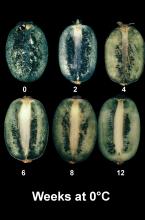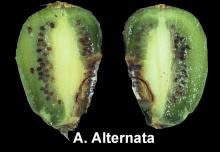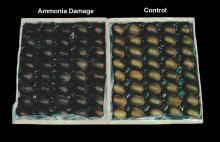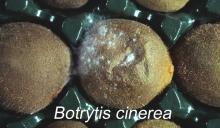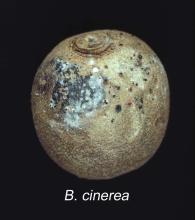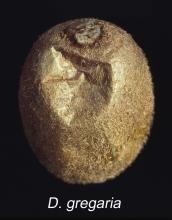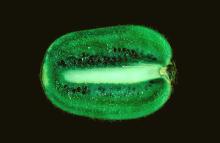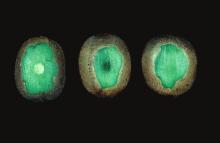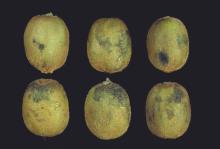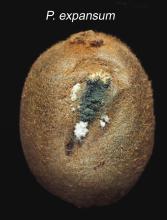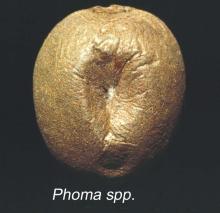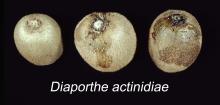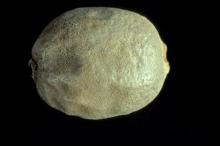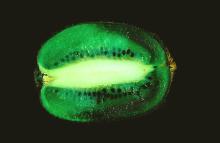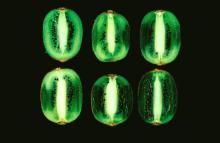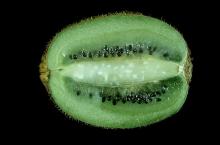Product Description
Maturity and Quality
- Minimum of 6.5% soluble solids content (SSC) at harvest
- Minimum flesh firmness of 14 lbf (penetration force with an 8-mm = 5/16 inch tip). Late harvested kiwifruits retain their firmness better than early harvested fruit and have higher SSC at harvest and when ripe
- Freedom from growth cracks, insect injury, bruises, scars, sunscald, internal breakdown, and decay
- Minimum of 14% SSC when ripe (ready to eat); a kiwifruit at 2-3 lb flesh firmness is considered ripe
- Kiwifruits are a good source of vitamin C
Postharvest Handling and Storage
0°C (32°F); highest freezing point is -1.5°C (29.3°F)
| Temperature | 0°C (32°F) |
5°C (41°F) |
10°C (50°F) |
15°C (59°F) |
20°C (68°F) |
|---|---|---|---|---|---|
| Rates of Respiration ml CO2/kg·hr |
1.5-2.0 | 3-4 | 5-7 | 9-12 | 15-20 |
To calculate heat production multiply ml CO2/kg·hr by 440 to get Btu/ton/day or by 122 to get kcal/metric ton/day.
- Kiwifruits are extremely sensitive to ethylene. As little as 5-10 ppb ethylene will induce fruit softening
- Avoid exposure of unripe kiwifruits to ethylene during harvest, transport, and storage unless accelerated ripening is desired. In such a case, kiwifruits can be exposed to 100 ppm ethylene for 12 hours at 0 to 10°C (32 to 68°F) and 90-95% humidity; the higher the temperature the faster the ripening rate.
90-95%
Less than 0.1 µl/kg·hr at 0°C (32°F), 0.1-0.5 µl/kg·hr at 20°C (68°F) for Production unripe kiwifruit. Ripe kiwifruit (less than 4 lbf firmness) produce 50-100 µl/kg·hr at 20°C (68°F).
- Optimum CA: 1-2% O2 + 3-5% CO2
- CA delays ripening and retains flesh firmness
- CO2 levels above 7% can cause internal breakdown of the flesh
- CA must be established within 2 days after harvest to maximize benefits; ethylene concentration should be kept below 20 ppb to avoid accelerated flesh softening and incidence of white core inclusions
Disorders
Freezing Damage. Flesh translucency starting at the stem end of the fruit and progressing toward the blossom end as the severity increases. Susceptible fruit become somewhat yellow fleshed with prolonged storage. There was no "graininess" observed in the fruit that showed these symptoms. Freezing damage can occur on early picked kiwifruit when stored at temperatures below 0°C (32°F) or when subjected to an early frost in the vineyard. Fruit frosted late in the season are usually affected on the shoulder where the cells collapse to cause a pinching of the fruit at the stem end.
Hard-Core. This disorder is induced by exposure of kiwifruit to ethylene plus carbon dioxide levels above 8 percent. The fruit core fails to ripen when the remainder of the fruit is soft and ripe.
Internal Breakdown. These symptoms start as a slight discoloration (water soaking) at the blossom end of the fruit. With time this progresses around the blossom end and ultimately encompasses a large part of the fruit. As symptoms progress a "graininess" develops below the fruit surface beginning in the area around the blossom end of the fruit.
Pericarp Granulation. The occurrence of granulation is predominantly at the stylar end of the fruit, but as in the case of translucency may extend up the sides of fruit. This disorder also is more severe with prolonged storage and after ripening at 20°C (68°F). There is no obvious correlation between pericarp translucency and granulation since symptoms can occur independently.
Pericarp Translucency. This disorder has been noted in both air- and CA-stored kiwifruit at 0°C (32°F). It appears as translucent patches in the outer pericarp tissue at the stylar end which may extend up the sides of the fruit. Pericarp translucency is more severe after prolonged storage, but it can be observed after 12 weeks of storage at 0°C (32°F). The presence of ethylene in the storage atmosphere exacerbates symptom development.
White-Core Inclusions. The occurrence of white-core inclusions is directly related to the presence of ethylene in CA storage. This disorder results in distinct white patches of core tissue that are obvious in ripe fruit. Symptoms have been observed as early as 3 weeks after storage at 0°C (32°F).
Several pathogens can cause postharvest deterioration of kiwifruit. Botrytis gray mold rot caused by Botrytis cinerea is the most important and can directly invade the fruit or enter through wounds. Kiwifruit become much more susceptible to Botrytis (and other fungi) as they soften. Thus, maintaining fruit firmness (by rapid cooling, cold storage, and use of controlled atmospheres) can significantly reduce pathological breakdown. Sunburned fruit and physically damaged fruit are also more susceptible to postharvest diseases.
[For more information, see our publication “Fruit Ripening and Ethylene Management”, available for purchase using our Publication order form.]




